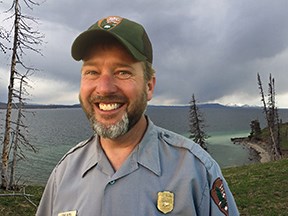“A thing is right when it tends to preserve the integrity, stability, and beauty of the biotic community. It is wrong when it tends otherwise.” Aldo Leopold
Article
Native Trout on the Rise

NPS Photo
When the park was established in 1872, early naturalists noted that about half of the waters were fishless, mostly because of waterfalls which precluded upstream movement of recolonizing fishes. Later, during a period of increasing popularity of the Yellowstone sport fishery, the newly established U.S. Fish Commission began to extensively stock the park’s waters with non-natives, including brown, brook, rainbow, and lake trout. Done more than a century ago as an attempt to increase an-gling opportunities, these actions had unintended consequences. Non-native fish caused serious negative impacts on native fish populations in some watersheds, and altered the parks natural ecology, particularly at Yellowstone Lake. It took a great deal of effort over many decades to alter our native fisheries. It will take a great deal more work to restore them.
As Aldo Leopold once said, “A thing is right when it tends to preserve the integrity, stability, and beauty of the biotic com-munity. It is wrong when it tends otherwise.”
Today, we have a strong scientific understanding of the impacts of non-native fish, and we have tools available to mitigate for them. Guided by scientific reviews, public input, and following an adaptive management approach, we are working to-gether with our partners to reduce long-term extinction risk of fluvial arctic grayling, westslope cutthroat trout, and Yellow-stone cutthroat trout. Our shared goal is as bold as it is difficult: restore the ecological role of Yellowstone’s native fish species.
In this edition of Yellowstone Science, we describe the significant progress that has already been made, along with the chal-lenges that lie ahead as we continue our efforts to conserve native fish. As most of what occurs with fish lies under the surface of the water and largely out of sight, we hope that these articles will be revealing, enlightening, and increase understanding of the management approaches taken as we promote the restoration and preservation of native fish.
Todd Koel
Senior Fisheries Biologist
Yellowstone Center for Resources
Part of a series of articles titled Yellowstone Science - Volume 25 Issue 1: Native Fish Conservation.
Tags
- yellowstone national park
- native fish
- native fish conservation
- todd koel
- ycr
- yellowstone center for resources
- yellowstone cutthroat trout
- yellowstone
- yellowstone lake
- aldo leopold
- brown trout
- brook trout
- rainbow trout
- osprey
- bald eagle
- grizzly bear
- black bear
- otter
- u.s. fish commission
- fluvial arctic grayling
- arctic grayling
- westslope cutthroat trout
- native fish restoration
- yellowstone science
- ys-25-1
- fish
- science
- research
- conservation
Last updated: July 26, 2017
